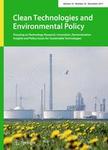版权所有:内蒙古大学图书馆 技术提供:维普资讯• 智图
内蒙古自治区呼和浩特市赛罕区大学西街235号 邮编: 010021

作者机构:Univ Antwerp Dept Engn Management Prinsstr 13 B-2000 Antwerp Belgium Royal Belgian Inst Nat Sci Geol Survey Belgium Jennerstr 13 B-1000 Brussels Belgium
出 版 物:《CLEAN TECHNOLOGIES AND ENVIRONMENTAL POLICY》 (清洁技术与环境政策)
年 卷 期:2022年第24卷第2期
页 面:467-491页
核心收录:
学科分类:0830[工学-环境科学与工程(可授工学、理学、农学学位)] 07[理学] 0702[理学-物理学]
基 金:Research Foundation Flanders (FWO) [S001619N]
主 题:Carbon Capture and Utilization Techno-Economic Assessment NPV Economic indicators Tutorial review Real Options Analysis
摘 要:Carbon Capture and Utilization (CCU) involves the capture and use of CO2 as a resource to create valuable products. The competitiveness of various CCU technologies has been investigated frequently resulting in a variety of economic feasibility studies and economic indicators. This study performs a tutorial review, in which practical guidance is given on the implementation of Techno-Economic Assessments (TEAs) for chemical CCU technologies. The tutorial review maps the differences in the methods and assumptions of economic feasibility studies for CCU technologies and advises how these studies can be improved in the future. A TEA framework, drafted by the CCU research community, is used as a benchmark in this review, to allow for objective comparisons between various economic feasibility studies. The four phases of an exhaustive TEA are (I) goal and scope, (II) data inventory, (III) calculation of indicators and (IV) interpretation. The tutorial review reveals that economic feasibility studies for chemical CCU technologies can and should be improved in various manners. Phases I and II are often skipped or incomplete. In Phase III, a very diverse indicator set is observed, which hampers comparability across CCU technologies. Phase IV, the interpretation of results, is often missing in the literature set or lacks thorough uncertainty and sensitivity analyses. The comparison with the TEA framework revealed the diversity in assumptions and methodological choices in the literature set. These findings suggest that future economic feasibility studies should be made in a more standardized way to improve both the quality and comparability of economic feasibility studies. Four improvements to the TEA framework are suggested: (i) focussing more on the impact of technical parameters in sensitivity analyses, (ii) adapting the assessment to the TRL of the technology, (iii) implementing ROA in the TEA and (iv) integrating an environmental assessment or LCA with the TEA. Further rese